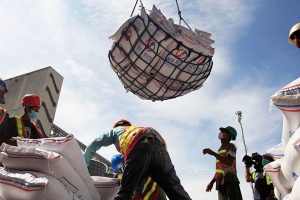FARMER GROUPS said the government’s plan to implement a flexible rice tariff next year is no substitute for restoring the tariff to its original 35%.
“Dapat ibalik at ipirmi ang ang taripa sa imported na bigas sa 35% o mas mataas pa. Kung seryoso ang gobyerno sa food security, dapat suportahan ang lokal na produksyon at hindi ang mga importer (The tariff on imported rice should be fixed at 35% or higher. If the government is serious about food security, it should support local production, not importers.),” Kilusang Magbubukid ng Pilipinas Secretary-General Ronnie Manalo was quoted as saying in a statement.
The 35% tariff on rice imports was the rate originally set on Southeast Asian grain when the Rice Tariffication Law of 2019 came into force. It has since been reduced to 15% in June 2024 as an inflation-containment measure.
President Ferdinand R. Marcos Jr. signed Executive Order (EO) No. 105 Friday, which modifies the rates of import duty on rice and establishes an Inter-Agency Group to oversee its implementation.
Starting Jan. 1, Most Favored Nation (MFN) rice tariffs will be adjusted based on global rice prices. The duty will increase by 5 percentage points (ppts) for every 5% drop in the international rice price or decrease 5 ppts for every 5% rise. The MFN tariff cannot fall below 15% or exceed 35%.
Under EO 105, the 15% base tariff will be maintained when imports resume in January, while the newly created Inter-Agency Group on Rice Tariff Adjustment will set the guidelines for future tariff changes.
Last week, the Economy and Development (ED) Council approved the recommendation of the Tariff and Related Matters Committee to adopt the flexible rice tariff adjustment system.
“The starting point should be to first restore the 35% tariff rate. Why would a 15% tariff be the benchmark?” Jayson H. Cainglet, executive director of the Samahang Industriya ng Agrikultura (SINAG), told BusinessWorld via Viber.
In a statement, SINAG also said the decision to implement a 15% base tariff rate disregards “both the sharp decline in global prices and the plight of local producers.”
“Hindi ba nahihiya ang (Department of Economy, Planning, and Development) na hanggang ngayon ay nasa emergency situation pa rin ang rice sector ng bansa, despite the drop in global rice prices by 50% (Isn’t DEPDev ashamed that the rice industry is still on an emergency footing despite the decline in global prices?),” Mr. Cainglet said.
He noted that global rice prices are down to around $330 per metric ton, from around $680 when the EO 62 was issued resetting the tariff to 15%.
Farmers also expressed wariness about the global price peg.
Raul Q. Montemayor, national manager of the Federation of Free Farmers, told BusinessWorld via Viber that tariff setting should not be “a simple mathematical exercise of mirroring international price movements.”
“If they use current international prices and prices do not move, then they will not adjust tariffs even if imports come in very cheap in unlimited volumes. The basis for adjustment should not only be international prices, but more importantly, the movements of local rice and palay prices,” he said.
Mr. Montemayor added that, given the lengthy process of tariff setting, he doubts whether the adjustments can react promptly to price movements, particularly for palay (unmilled rice) with a short three-month harvest period.
Danilo V. Fausto, president of the Philippine Chamber of Agriculture and Food, Inc., added: “International prices change every day. Our experience is that our reaction takes time, and the effect of policy changes becomes irrelevant and sometimes very damaging, especially to the farm producers,” he told BusinessWorld via Viber.
Mr. Fausto also said that anticipation of tariff shifts could encourage speculative behavior. “Implementing a flexible tariff adjustment might invite hoarding and technical smuggling, maximizing traders’ profits as they anticipate government moves,” he said. — Vonn Andrei E. Villamiel

